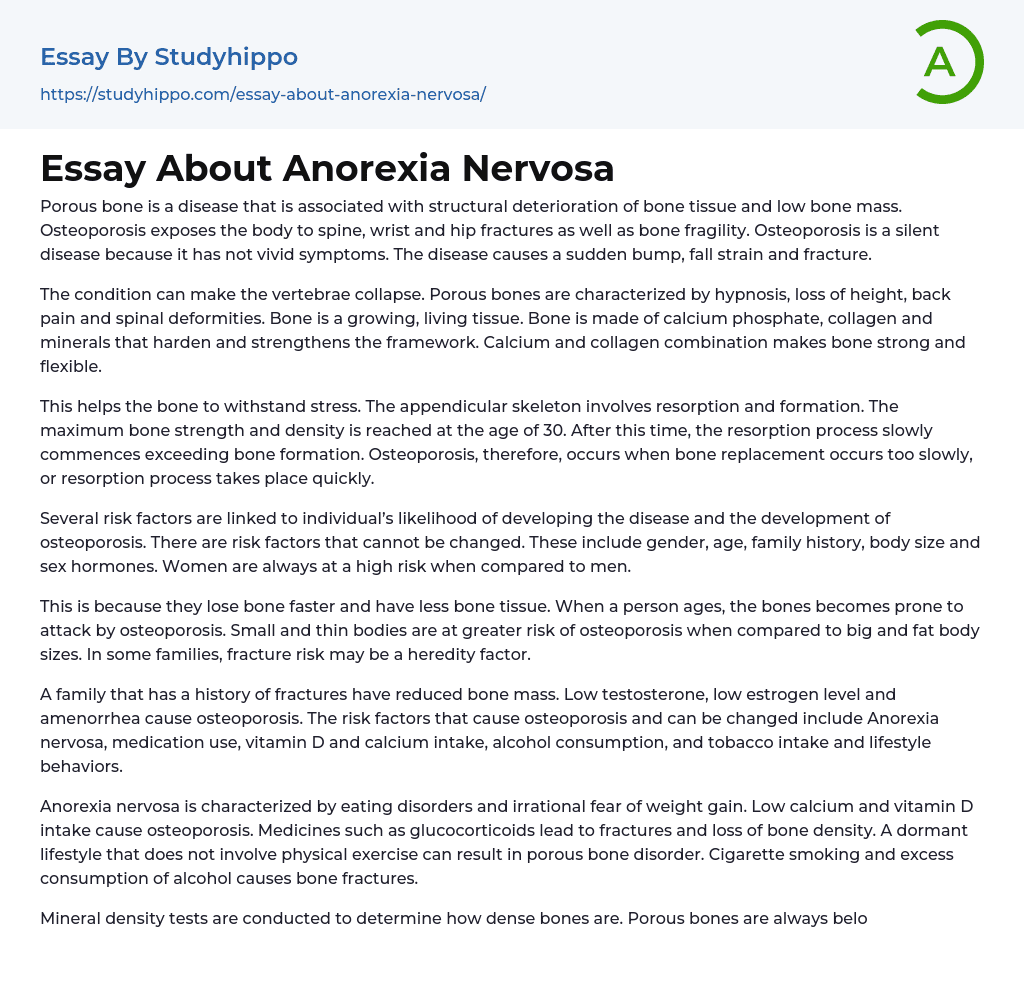Osteoporosis, or porous bone, is a disease that causes the deterioration of bone tissue and a decrease in bone mass. It increases the risk of fractures in the spine, wrist, and hip while also weakening bones. Unlike many other diseases, osteoporosis often lacks noticeable symptoms and remains undetected. Usually, it presents itself through unexpected bumps, falls, strains, and fractures.
The condition can lead to the collapse of vertebrae, resulting in porous bones characterized by hypnosis, loss of height, back pain, and spinal deformities. Bone is composed of calcium phosphate, collagen, and minerals that strengthen and harden the framework. The combination of calcium and collagen provides bone with both strength and flexibility to endure stress.
The appendicular skeleton undergoes a combination of resorption and formation, achieving maximum bone strength and density at the age of 30. However, after this point, the process of resorption gra
...dually exceeds bone formation. Consequently, when bone replacement is slow or resorption happens rapidly, osteoporosis begins to develop.
There are several risk factors that can increase the likelihood of developing osteoporosis, including gender, age, family history, body size, and sex hormones. Women are especially at risk due to factors like accelerated bone loss and reduced bone tissue. Furthermore, as individuals get older, their bones become more vulnerable to osteoporosis.
Individuals with small and thin bodies have a higher risk of developing osteoporosis compared to those with larger and heavier bodies. In some cases, the susceptibility to fractures can be hereditary, leading to reduced bone mass. Additionally, low levels of testosterone, estrogen, and amenorrhea can also contribute to the development of osteoporosis.
The development of osteoporosis can be attributed to various risk factors, including Anorexia nervosa, medication use,
inadequate intake of vitamin D and calcium, excessive alcohol consumption, tobacco use, and certain lifestyle behaviors.
Anorexia nervosa is characterized by eating disorders and an irrational fear of weight gain. Additionally, insufficient intake of calcium and vitamin D can also contribute to the occurrence of osteoporosis. Furthermore, specific medications like glucocorticoids can result in fractures and reduced bone density.
Osteoporosis, also known as porous bone disorder, can develop due to a sedentary lifestyle. This condition is characterized by lower than ideal bone mineral density (BMD). Factors like excessive alcohol consumption and cigarette smoking increase the risk of bone fractures. Mineral density tests are commonly used to assess bone density. X-ray absorptiometry (DEXA) is a technique that measures hip and spine bone density, assisting in determining fracture likelihood (Hodgson et al, 2013).
Both quantitative computed tomography and ultrasound are used to evaluate bone density, while bone densitometry, which uses x-ray technology, offers precise measurements of this density. To prevent Osteoporosis, it is essential to take various preventive measures such as ensuring adequate intake of calcium and vitamin D through the diet. Sufficient consumption of calcium helps reduce the occurrence of fractures, low bone mass, and rapid bone loss. Furthermore, participating in physical exercise improves bone strength.
Regular exercise is advantageous for one's overall health as it fosters the development of robust bones and a high bone mass. Nevertheless, women who smoke may experience a decline in estrogen levels, which can potentially lead to early menopause and porous bone disorder. It is crucial for individuals to abstain from alcohol consumption, smoking, and drugs that might contribute to porous bone.
The utilization of glucocorticoids, phenytoin, and barbiturates diminishes the activity of osteoblasts, thereby
causing a decline in bone collagen synthesis (Hodgson et al., 2013). This reduction ultimately triggers apoptosis of osteoblasts, resulting in premature death during their synthesis phase.
The healing process of fractures and micro-fractures is hindered by the use of glucocorticoids, which increase osteocyte apoptosis. To effectively prevent and treat osteoporosis, a holistic approach that emphasizes exercise, proper nutrition, and safety precautions is recommended. It is advisable to include mineral-rich foods and vegetables in your diet. Regularly participating in physical activity greatly improves bone strength.
Several drugs are employed for the prevention of osteoporosis, such as antagonists and bisphosphonates. Treatment methods also include estrogen therapy, calcitonin, and hormone therapy.




